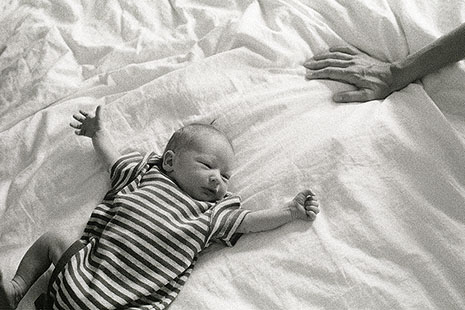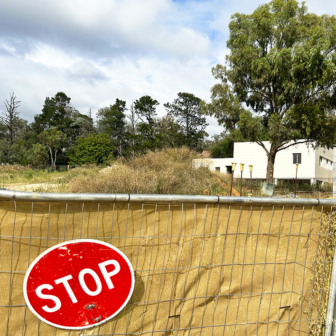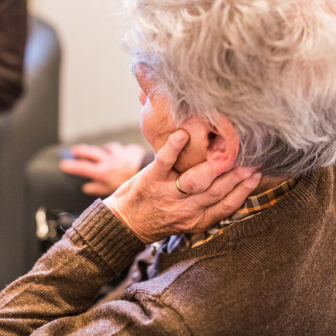When Sister Brigid Arthur first encountered “Ana” she was “sparky,” despite being in detention. She appeared physically and mentally well, and was as excited as “the brightest young mother-to-be” about the imminent birth of her first child. The second time they met, the baby was one week old and Ana appeared sad and confused. Sister Brigid recalls her saying tearfully, “I shouldn’t have had this baby here,” and “I shouldn’t have had a baby at all under these circumstances.”
On each subsequent visit the situation was worse. “Her eyes got duller and duller,” says Arthur. “Eventually she became hugely depressed and ended up in hospital in neonatal psychiatric care.”
Ana is one of several new mothers among the asylum seekers held at MITA, the Melbourne Immigration Transit Accommodation facility in the Melbourne suburb of Broadmeadows. Described as “alternative accommodation in a low security setting,” MITA is nevertheless a “place of immigration detention.” At the end of April, 306 people were held at MITA – 122 men, seventy-five women and 109 children.
Ana was transferred to the facility from Nauru late in her pregnancy. Her husband was brought to Melbourne later, in time for the birth of their baby. Other mothers have been transferred to MITA from Christmas Island, which also lacks adequate obstetric facilities. Among this group, a slide into mental illness has become increasingly common.
Brigid Arthur says Ana’s illness is different from the postnatal depression that affects some new mothers in the general community. She is convinced that it is linked to the experience of being held in detention with her newborn baby, not least because of the number of mothers she has visited at MITA who have ended up in hospital in a similar condition, usually after attempting an act of self-harm. “This is the total pattern now,” she says. “There is only one thing causing it and that is detention.”
Arthur has been working with asylum seekers since 2001, when she and other nuns from her order founded the Brigidine Asylum Seekers Project. A regular visitor to MITA, she witnesses the torment of fathers as well as of mothers. Mizam, for instance, whose wife has been hospitalised twice since giving birth to their second child, feels deeply his responsibility for their decision to seek refuge in Australia, which landed them in Nauru. He is also acutely concerned about the combined effect of prolonged detention and his wife’s illness on their first child, who is only three years old.
The best that mental health professionals can do is patch these mothers up temporarily before they are sent back to the same conditions that made them sick in the first place – this time with the added stress of being kept under constant surveillance. “The guards can’t win,” acknowledges Arthur. “They need to keep a close watch on these mothers to check they are okay and prevent any repeat attempt at self-harm. But the surveillance itself exacerbates the women’s problems.”
Louise Newman, director of the Centre for Developmental Psychiatry and Psychology at Monash University, says that the vast majority of medical health professionals would agree that a detention centre is not a suitable environment for a new mother and her baby. “In the context of the terrible uncertainty of their situation,” she says, “mothers often feel stressed and guilty about bringing a new child into the world. Their partners often share that sense of hopelessness and despair.”
Newman says that there is “a steady stream” of pregnant women being brought to the mainland to get access to medical services that aren’t available in Nauru or Christmas Island. (There are currently no women or children held at Manus.) “There are very limited services available at detention centres like MITA,” says Newman, who practises at a psychiatric clinic that has admitted mothers and babies from the facility. “Services like ours are trying to help where we can, but there is no formal arrangement with the immigration department.”
Until it was disbanded in December last year, Newman was a member of the federal government’s Immigration Health Advisory Group. Without the input of the professionals on that body, there is little external scrutiny of what is going on in immigration detention. Newman has observed one baby in MITA who is “badly losing weight” because the mother is incapable of feeding. The young, inexperienced father is doing his best to cope but is also showing signs of depressive illness. Some mothers are suicidal; others threaten harm to themselves or their babies.
Both Arthur and Newman believe that it is impossible for the mothers to get better in detention, not least because recovery could result in their being sent to Nauru. “They are all told on arrival that they will be sent back six weeks after their babies are born,” says Arthur. “They dread the heat, the boredom, the frustration, the constant fear of an eruption of relationships between detainees and staff that will result in violence.”
Whether Ana is ultimately returned to Nauru may depend on the courts. Her baby is one of seventy-two children born in detention in Australia who are challenging their status as “unauthorised maritime arrivals” in a case due to be heard in the Federal Circuit Court in mid October. Brigid Arthur has agreed to be the babies’ litigation guardian, which means that the parents have given her permission to instruct solicitors on the babies’ behalf. “The parents are not in a position to provide instructions on a day-to-day basis because they are in detention in different parts of the country,” says Katie Robertson from Maurice Blackburn Lawyers, who have taken on the case pro bono.
If it succeeds, the litigation will challenge the hardline arrangements introduced on 19 July 2013, when prime minister Kevin Rudd declared that “asylum seekers who come here by boat without a visa will never be settled in Australia.” Anyone who arrived after that date can be transferred to Nauru or Manus for detention and processing.
The court case was prompted by Baby Ferouz, who was born in Brisbane’s Mater Hospital in November last year after his mother Latifer was brought to Australia from detention in Nauru. Suffering respiratory problems, Baby Ferouz made headlines when it was reported that he had been separated from his mother for up to eighteen hours a day while she was locked up in immigration detention.
To prevent Latifer and Ferouz, and other parents and newborns from being shipped to Nauru, the legal team must convince the courts that Ferouz and his fellow infant litigants are not “unauthorised maritime arrivals.”
Section 5AA of the Migration Act defines an unauthorised maritime arrival as “a person who entered Australia by sea.” It goes on to say that entering Australia by sea means entering “the migration zone except on an aircraft.” This is a remarkably vague, catch-all provision. Maurice Blackburn’s Jacob Varghese says it means the question before the court is whether babies born in Australian hospitals can be deemed to have entered the country by sea because they did not come on a plane.
It will be a highly technical argument, says Varghese. “It’s possible sometimes for legislation to say that black is white and white is black, but in such cases the law must usually be expressed extremely clearly to satisfy a court,” he says. In this instance, it appears that neither the drafters of the definition, nor the parliamentarians who passed it into law ever stopped to consider how it might apply to the status of the Australian-born children of asylum seekers.
“We will be arguing that in this situation the normal English-language meaning of ‘enter by sea’ should apply,” says Varghese, “in which case it is clear that a baby born in an Australian hospital did not arrive here on a boat.”
Whether a baby born in Australia is entitled to apply for a protection visa is one issue, but there’s also the question of whether any of these babies will be entitled to apply for Australian citizenship. Baby Ferouz is a special case because he is the child of Rohingyan asylum seekers. “The Burmese government does not recognise members of the Rohingyan minority as citizens, which makes Baby Ferouz stateless,” says Varghese. “On this basis we think this Australian-born baby should be granted Australian citizenship.”
Most of the other babies aren’t stateless, but if the court finds that they are not unauthorised maritime arrivals then they can lodge an onshore application for a protection visa, a right that they are currently denied. The babies and their parents could remain in Australia while their cases are processed, and stay here if they are recognised as refugees. In other words, Ana and other parents of newborns would potentially be spared the fate of being sent to offshore detention.
Varghese acknowledges that a win in the courts could have unintended consequences. The Australian government might respond by ensuring that all pregnant women give birth in Nauru, despite the rudimentary medical facilities available there. But he thinks this is unlikely. “At some point you hope there are limits even to this government’s cruelty.”
A leaked report prepared for the government by medical professionals who visited Nauru in February notes that “the Nauruan maternal mortality ratio is thirty-five times higher than the comparative value for Australia.” The report describes “substantial ongoing risk factors for physical and mental health problems in people held in detention on Nauru” and identifies gaps in child health screening, and child health expertise and services in particular. It also raises concerns about adequate protection for children from physical and sexual abuse.
At Senate estimates in February, however, the government indicated that it is upgrading antenatal, postnatal and maternity services in Nauru. Assistant immigration minister Michaelia Cash said the Nauru hospital delivers around 360 babies each year and she made clear that the government expects asylum seekers to have their babies there too. “The hospital has two delivery beds, six postnatal beds and a special-care baby unit with a neonatal incubator, infant warmer, oxygen, standard neonatal resuscitation equipment and nasogastric feeding capability,” she said. “The hospital has the capacity to perform caesarean sections and other surgical interventions and has pain-relief options.”
According to information provided at Senate estimates, there were thirteen pregnant women detained on Nauru in February, fifty-three on Christmas Island and forty-three in mainland detention centres. A spokesperson for the immigration minister, Scott Morrison, says these women “are provided care in line with Australian community standards, including access to antenatal classes and medical check-ups” and that given its duty of care, the department ensures that women give birth “under appropriate and safe arrangements.”
But the immigration minister’s office failed to answer questions about how many babies have been born to women in detention in the past year and how many women have been transferred from Christmas Island or Nauru to give birth on the mainland.
If the action in the Federal Circuit Court is successful then the government might also seek to broaden the Migration Act’s definition of unauthorised maritime arrivals to include their Australian-born children. Again, Varghese thinks this unlikely. Noting that the government doesn’t have a majority in the Senate, he says, “a debate in federal parliament about whether or not newborn babies should be packed off to Nauru could be a welcome thing.”
While the legal action offers asylum seekers with newborns some longer-term hope of staying in Australia, for now the experience of detention continues to erode their well-being. Katie Robertson holds grave fears for the welfare of many of her clients, particularly those she visited recently on Christmas Island.
Robertson says asylum-seeker children there have few toys, limited activities, little stimulation and few places to play. The ground is so hard and stony that babies cannot be put down to crawl. It is a place where asylum seekers, including babies, are routinely referred to by their identification numbers rather than their names. The lawyers who travelled to Christmas Island were so upset by what they witnessed that they have started a drive among colleagues and friends to collect children’s toys and personal effects to send to families there.
As the federal government winds up mainland detention centres in Darwin and Inverbrackie, in the Adelaide Hills, the number of young children on Christmas Island is growing. In a pre-dawn operation in mid June, five families were moved there from Inverbrackie at very short notice. Jacob Varghese says some of Maurice Blackburn’s clients with babies just two months old have been transferred in this way. “The parents are just told to pack up and leave, they have no practical opportunity to call their lawyers or others to tell them,” he says.
Varghese says the Christmas Island centre is not a suitable place for babies and children, a view shared by a child psychiatrist and a paediatrician, who spent a week on Christmas Island in March for the Human Rights Commission’s inquiry into children in immigration detention. The pair reported finding “an impoverished and harsh environment with little opportunity for safe play and exploration, education, physical exercise or for nurturing family time.”
At the time, the 1700 detainees on Christmas Island included 356 children and about twenty-five babies who had been born in detention. Parents were forced to line up for nappies, which would be dispensed three at a time. Baby wipes and scoops of formula were also rationed.
Officers with torches interrupted sleep twice each night when they knocked on the door to conduct a roll call. There is the constant fear that one of those interruptions in the early hours of the morning could be an “extraction,” when detainees, including families with children, are transferred without warning to Nauru. As Robertson observes, “To wake up and find their neighbours have been taken away in the night reawakens the trauma these people have already experienced.”
There is another option. It is entirely within the government’s power to move children out of formal detention facilities and to accommodate them in the community. In fact, such a move would appear to be consistent with existing legislation.
Section 4AA of the Migration Act states that “Parliament affirms as a principle that a minor shall only be detained as a measure of last resort.” According to the immigration department’s procedural advice manual (effectively a compendium of the minister’s instructions to departmental officers), when minors are detained, this should be done “when and wherever possible” in a community setting “rather than under traditional detention arrangements.”
Under Section 197AB of the Act, the minister has the power to move people out of formal detention and into such a community setting by making what is called a “residence determination.” This provision was introduced by the Howard government in 2005 and enabled health professionals like Louise Newman to make representations on behalf of asylum seekers who were suffering severe mental illness or other health problems as a result of their detention. Departmental officers would bring such cases to the minister’s attention, and in many instances asylum seekers were transferred to a community setting. A dramatic improvement in health generally followed.
In theory this can still happen. If it did, then families like Ana’s would be the beneficiaries. “These babies and their parents need to be in the community if their health is to improve,” says Newman. But the minister can’t be compelled to use this power, or even to consider cases that are brought to his attention. Newman says departmental staff and medical professionals have been pressured not to make such requests in the first place, and where requests have been made, they have not received a response.
Immigration minister Scott Morrison’s office did not respond to questions about how many times he has used his power to move asylum seekers into community detention, but he has explicitly discouraged his department from asking him even to consider the cases of any asylum seekers who arrived after the deadline Kevin Rudd imposed last year.
In a 22 March update to the procedural advice manual, Morrison states that unless he requests it, or there are exceptional reasons, he “would not expect” the department to refer to him any person who “arrived after 19 July 2013.”
Both the government and the Labor opposition remain committed to offshore processing, arguing that it is necessary to save lives at sea by deterring asylum seekers from trying to reach Australia by boat.
“It’s a seductive argument,” says Sister Brigid, “in the sense that you’d have to be a monster to say that it’s acceptable that nearly 2000 people have drowned at sea trying to get to Australia. The question is whether we have really tried to find another solution.” Have we really tried to work with the United Nations High Commissioner for Refugees, she asks, to set up a regional processing system that might offer people an alternative to getting on boats? “Of course we can’t just let people drown. But what we are doing now is calculated cruelty.”
Jacob Varghese says the only way deterrence can work is if we create conditions “that are as bad as the situation in the places these people have fled from.” He compares it to “creating a totalitarian regime within our own country.” Louise Newman is even blunter. “If we send these young families back to Nauru,” she says, “we will be condemning some babies to death.” •




